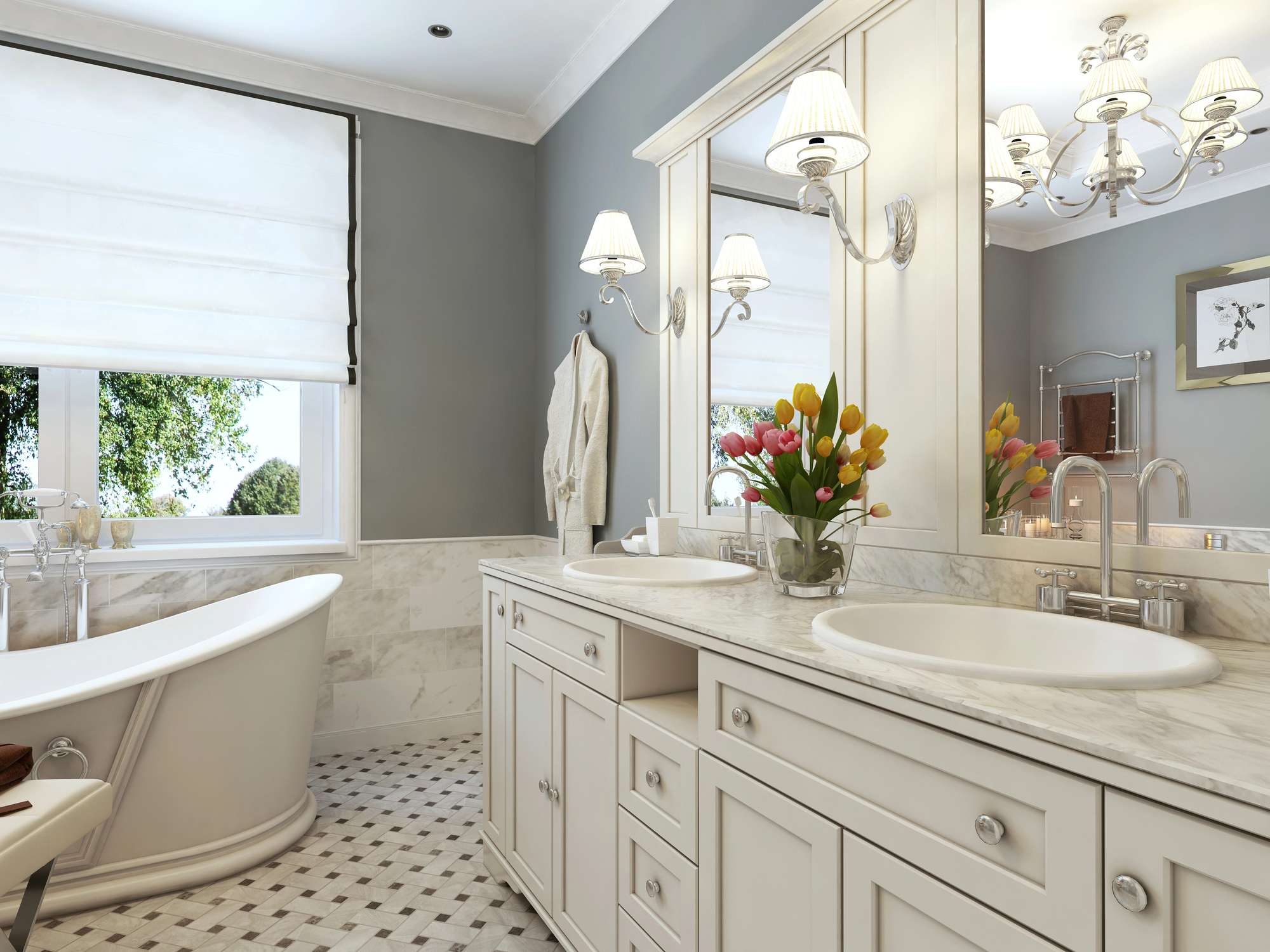Choosing the Right Paint for Your Bathroom

A bathroom is a high-traffic area that’s constantly exposed to moisture, humidity, and potential mildew growth. Choosing the right paint is crucial for ensuring your bathroom looks great and stays protected for years to come.
Understanding Bathroom Paint Properties
The key properties of bathroom paint that make it suitable for this demanding environment are:
* Moisture Resistance: Bathroom paint needs to withstand constant exposure to water and steam without peeling, cracking, or blistering.
* Mildew Resistance: Mildew is a common problem in humid environments, and mildew-resistant paint helps prevent its growth and discoloration.
* Stain Resistance: Bathroom paint should resist stains from soap, toothpaste, and other common bathroom products.
Types of Bathroom Paint
There are several types of paint commonly used in bathrooms, each with its own advantages and disadvantages:
* Acrylic Latex Paint: This is the most popular choice for bathrooms due to its excellent moisture resistance, mildew resistance, and ease of application. It dries quickly, is low-odor, and cleans up easily with soap and water.
* Oil-Based Paint: Oil-based paint offers superior durability and moisture resistance compared to latex paint, making it a good choice for high-traffic areas and surfaces that get a lot of wear and tear. However, it takes longer to dry, has a strong odor, and requires mineral spirits for cleanup.
* Epoxy Paint: Epoxy paint is highly durable and moisture-resistant, making it ideal for surfaces that are frequently exposed to water, such as shower stalls and bathtubs. It creates a hard, glossy finish that is resistant to stains and chemicals.
| Paint Type | Moisture Resistance | Mildew Resistance | Stain Resistance | Suitability for Surfaces |
|---|---|---|---|---|
| Acrylic Latex | Excellent | Good | Good | Walls, ceilings, trim |
| Oil-Based | Very Good | Good | Excellent | High-traffic areas, trim, doors |
| Epoxy | Excellent | Excellent | Excellent | Shower stalls, bathtubs, floors |
Choosing the Right Sheen
The sheen of a paint refers to its level of glossiness. It can significantly impact the look and feel of your bathroom.
* Flat Sheen: This provides a matte finish that hides imperfections well but can be difficult to clean.
* Eggshell Sheen: This offers a soft, low-gloss finish that is easy to clean and provides a good balance between hiding imperfections and reflecting light.
* Satin Sheen: This has a slightly glossy finish that is easy to clean and provides a good amount of light reflection.
* Semi-Gloss Sheen: This has a noticeable gloss that is very easy to clean and reflects a lot of light. It is often used on trim and doors.
* Gloss Sheen: This has the highest gloss level and is the most durable and easiest to clean. It is typically used on trim and doors in high-traffic areas.
Tip: For most bathrooms, an eggshell or satin sheen is a good choice. It provides a balance between durability, ease of cleaning, and a pleasant aesthetic.
Preparing Your Bathroom for Painting: Good Quality Bathroom Paint

A well-prepared bathroom is crucial for a successful paint job. Proper preparation ensures a smooth, even finish and helps the paint adhere better, lasting longer. This involves a series of steps that, while seemingly tedious, are essential for a professional-looking result.
Cleaning the Bathroom
Before you start painting, a thorough cleaning is essential. This removes dirt, grime, soap scum, and any other residues that could interfere with the paint’s adhesion.
- Remove all items from the bathroom, including towels, toiletries, and bathroom accessories. This allows for better access to the walls and prevents accidental spills or paint splatters.
- Use a cleaning solution designed for bathroom surfaces to clean the walls, floors, and ceilings. Pay special attention to areas prone to mildew, such as shower stalls, tubs, and grout lines.
- Allow the bathroom to dry completely before proceeding to the next step.
Patching and Sanding
Once the bathroom is clean, it’s time to address any imperfections in the walls and ceilings. This may involve patching cracks, holes, or dents.
- Use a putty knife to apply spackling compound to fill in any cracks or holes. Ensure the compound is applied smoothly and flush with the surface.
- Allow the spackling compound to dry completely before sanding it smooth. This ensures a smooth and even surface for painting.
- Sand any rough or uneven areas on the walls and ceilings with fine-grit sandpaper. This removes any bumps or ridges that could show through the paint.
Masking and Protecting Surfaces
Masking is crucial to protect surfaces that are not being painted. This prevents accidental paint splatters and ensures a clean, professional finish.
- Use painter’s tape to mask off areas that you don’t want to paint, such as trim, windows, doors, and fixtures. Apply the tape carefully, pressing it firmly against the surface to create a good seal.
- Cover any fixtures or surfaces that you don’t want to paint with drop cloths or plastic sheeting. This protects them from paint spills and splatters.
- Remove any electrical outlet covers and light fixtures before painting. This ensures that the paint can be applied evenly and prevents any accidental damage.
Priming the Bathroom
Priming is an essential step in preparing the bathroom for painting. It creates a smooth, even surface for the paint to adhere to and helps to seal any imperfections in the walls and ceilings.
- Use a primer specifically designed for bathrooms. This type of primer is formulated to resist moisture and mildew, which are common problems in bathrooms.
- Apply the primer evenly using a roller or brush. Make sure to cover the entire surface, including any patched areas.
- Allow the primer to dry completely before painting. This ensures that the paint will adhere properly and prevents any problems with peeling or cracking.
Painting Techniques for a Professional Finish

Achieving a professional-looking paint job in your bathroom requires careful preparation and the right painting techniques. The key is to apply the paint smoothly and evenly, avoiding brushstrokes, roller marks, and drips. This section will explore the best techniques for applying bathroom paint using brushes, rollers, and sprayers, offering tips for achieving a flawless finish.
Applying Paint with a Brush
Using a brush is often the best option for painting detailed areas, such as corners, trim, and around fixtures. A good quality brush with angled bristles is ideal for bathroom painting.
Here are some tips for applying paint with a brush:
- Load the brush with a moderate amount of paint, avoiding overloading. Excess paint can lead to drips and uneven coverage.
- Use long, smooth strokes, overlapping each stroke by about 50%. This ensures even coverage and prevents brush marks.
- For corners and edges, use a smaller brush or the tip of your brush to create a clean line.
- Avoid pressing too hard, as this can cause brushstrokes. Let the weight of the brush do the work.
Applying Paint with a Roller, Good quality bathroom paint
Rollers are perfect for covering large areas like walls and ceilings quickly and efficiently. For bathroom painting, a short-nap roller is recommended, as it provides a smooth finish and is less likely to leave roller marks.
Here are some tips for applying paint with a roller:
- Load the roller with paint, ensuring it is evenly coated but not overloaded.
- Roll in a “W” pattern, overlapping each stroke by about 50%. This ensures even coverage and minimizes roller marks.
- Use even pressure and avoid rolling over the same area multiple times.
- After each pass, “tip off” the roller by lightly rolling it along the edge of the painted area to remove any excess paint.
Applying Paint with a Sprayer
Sprayers offer the fastest and most efficient way to paint a bathroom, especially large areas like walls and ceilings. However, using a sprayer requires practice and caution to avoid overspray and drips.
Here are some tips for applying paint with a sprayer:
- Use a sprayer designed for water-based paints. The spray pattern should be adjusted for the specific area being painted.
- Start with a light coat, holding the sprayer about 12 inches away from the surface. Overlap each pass by about 50%.
- Apply thin coats to avoid drips and runs. Allow each coat to dry completely before applying the next.
- Use masking tape and drop cloths to protect surrounding areas from overspray.
Step-by-Step Guide to Painting a Bathroom
- Prepare the Bathroom: This includes removing all fixtures, covering surfaces with drop cloths, and cleaning the walls and trim. Thoroughly clean the walls and trim with a damp cloth to remove dirt and grime.
- Patch and Sand: Fill any holes or cracks with spackling compound and let it dry completely. Sand the patched areas smooth for a seamless finish.
- Prime the Walls and Trim: Apply a primer to the walls and trim. This helps the paint adhere better and creates a more even finish. Use a brush for corners and trim and a roller for larger areas.
- Paint the Trim: Use a brush to apply the paint to the trim, starting with the edges and corners. Use long, smooth strokes, overlapping each stroke by about 50%.
- Paint the Ceiling: Use a roller to apply the paint to the ceiling. Start in the center and work your way outwards. Overlap each stroke by about 50% and use even pressure.
- Paint the Walls: Use a roller to apply the paint to the walls. Start at the top and work your way down, using long, smooth strokes. Overlap each stroke by about 50% and use even pressure.
- Clean Up: After painting, clean your brushes, rollers, and sprayers thoroughly with soap and water. Remove all drop cloths and masking tape.
